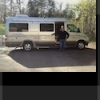
It wasn’t planned. They just sort of took it over once they discovered how much fun it was. And between games, I became babysitter-in-chief.
We went through four bags of popcorn. Pretty much a case of bottled water.
We charged iPods and iPads and watched TV and the DVD. Oh yeah, the onboard bathroom came in pretty handy, too.
My dog Tai loved the attention, getting pretty much non stop pets from kids – his favorite type of human.
Several Moms and Dads from the team also poked their heads inside and were duly impressed. But I think what they liked most about it was they knew where their kids were.
Me? Hey, kids are my favorite type of humans, too.
http://vimeo.com/61458975
- Read more...
- 0 comments
- 1207 views

